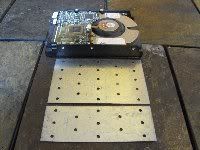Rather than responding in the comments area to Hollie's comment on
Ice Cream Machine, I thought I would just make a new post. Her question was, "isn't that a sorbet?" No, Hollie, that wasn't a sorbet or even a sherbet. There are a few terms tossed around for frozen, churned desserts, and there are differences. Some of it has to do with dairy content, but not all.
Sorbet: This dessert generally contains fruit puree or juice, but can contain other things, such as coffee or chocolate. The important thing here is that there is no dairy content. So Hollie, with all the half and half in my recipe, it's definitely not sorbet.
Sherbet/Sherbert: You'd think my recipe would fall under this category, because sherbet can have dairy in it. But as it turns out, sherbet only contains a small amount of dairy, < 3%. The terms sherbet and sorbet are often used interchangeably, and I guess I'm not going to stop that with my little post. But as far as I'm concerned, they are different.
Ice Cream: Once you get above 3% dairy, your dessert becomes "ice cream". This is a pretty generic term that gets tossed around, and is applied to everything from sorbet to gelato. You can have large amounts of fruit puree like I had, or you can just keep it as simple as frozen, churned, sweetened milk or cream. I have a friend that is a big fan of unflavored ice cream: not even vanilla gets in the way of the taste of milk. One day I will have to try it.
Frozen Custard/Premium Ice Cream: Once you add egg to the mix, ice cream technically becomes a frozen custard. But most people still just call it ice cream. I have yet to see a premium ice cream that is not actually a frozen custard, but I'm sure one exists somewhere. From a technical standpoint, there is a definite advantage to using egg, which will help the ice cream set up a little more easily in the churn. It also adds a nice creaminess.
Frozen Yogurt: There's not really a whole lot of difference between ice cream and frozen yogurt, other than the former using cream (or at least half and half) and the latter using yogurt. Because of the yogurt, it's often a little more tart, and generally lower in fat.
Granita: This Italian dessert is kind of like sorbet, but with much larger ice crystals. This is due to the preparation, which is more of a shaved ice technique than a churning technique. The method that I see most often involves pouring flavorful liquid (usually coffee, but sometimes fruit juice) into a cookie sheet and putting it in the freezer, scraping with a fork every couple of hours or so.
Gelato: This is an Italian variety of ice cream who's name I have often seen mis-used and abused in America, so let's set the record straight. One big difference is the low dairy content: almost as low as sherbet. I have seen some gelatos with no diary at all. Gelato also has a higher sugar content than ice cream, and usually involves egg. I have also heard Italians mention some sort of mysterious stabilizer, which I have
experimented with before. It's still unclear to me what it is, and if it's actually a requirement. Gelato is churned like ice cream, but has much less air incorporated into it, and is meant to be served fresh, the same day that it is made. While not necessary, gelato generally has a pretty high fruit content.
I have often heard the terms "gelato" and "spumoni" used interchangeably. Let me be clear on this: spumoni is a
type of gelato. Not all gelato is spumoni. Spumoni is a layers ice cream, kind of like Neapolitan ice cream in America, but containing things like fruits and nuts.
Kulfi: My favorite dessert from India, this concoction differs from ice cream largely in that it is not churned. It generally contains flavors indigenous to India, like cardamom or pistachios. Americans be warned: it would seem that India loves their desserts sweet, as is evidenced in pretty much every kulfi I have ever eaten. It's not too sweet for me, but it's close.
I hope that clears things up a little bit for some of you. Obviously I haven't hit every type of frozen dessert, but there are a few important ones.


